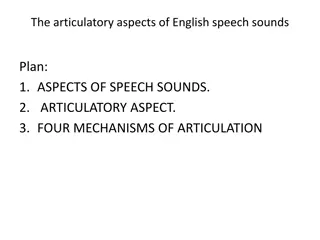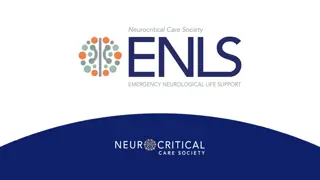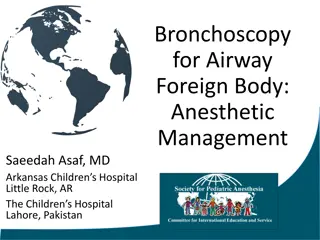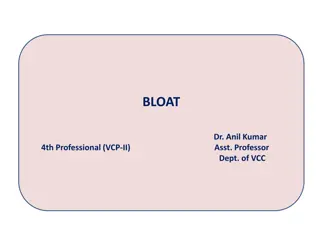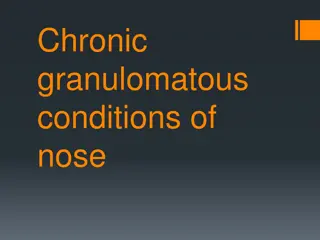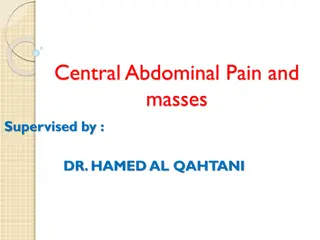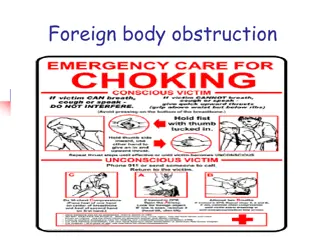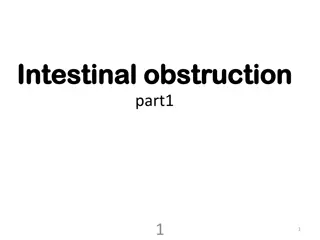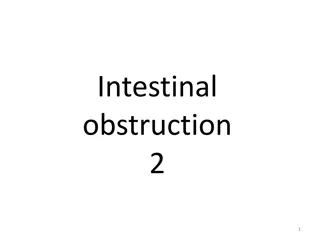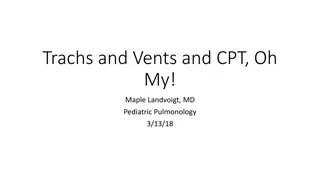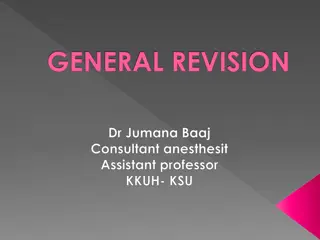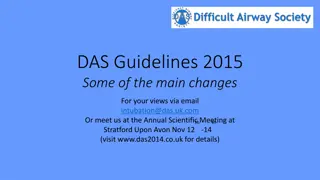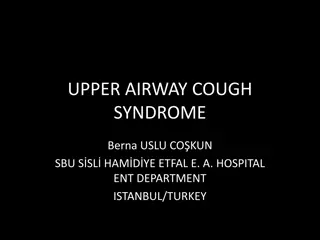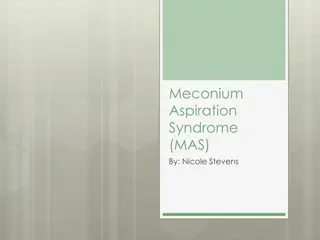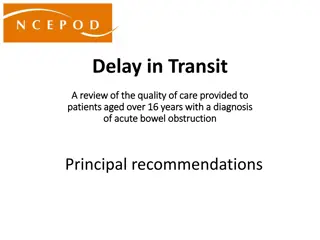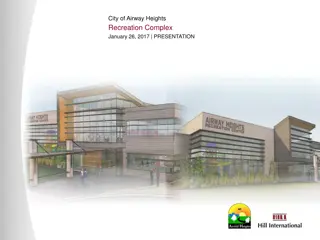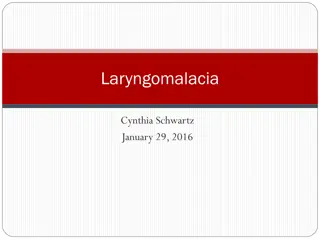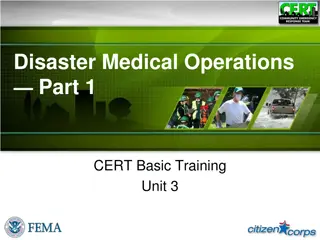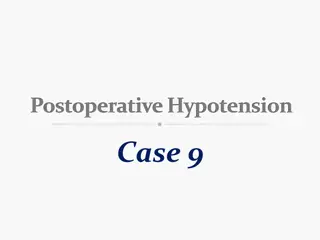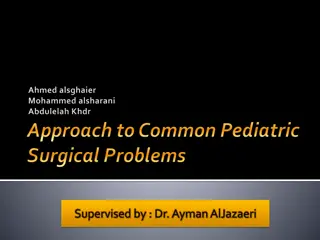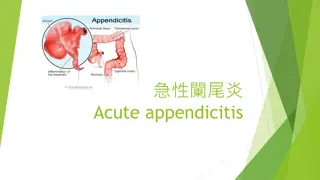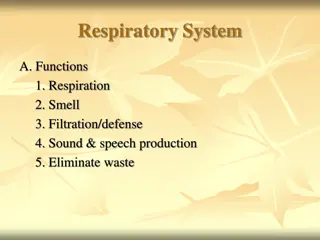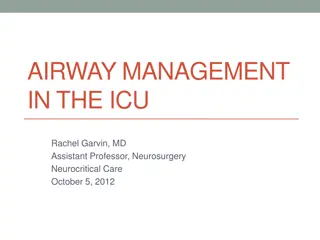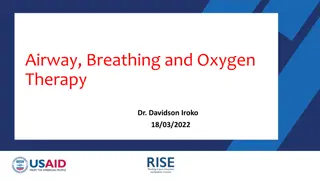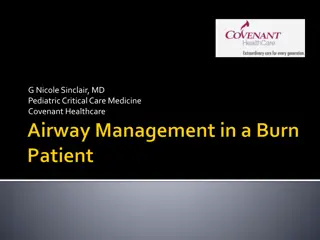Understanding Liver Function Tests in Cholestatic Injury
Cholestatic liver disease affects Alkaline Phosphatase (ALP) and bilirubin levels, indicating bile duct damage. GGT and 5'-Nucleotidase help differentiate hepatobiliary vs. bone origin of ALP elevation. ALP is produced by bile duct epithelium and can be normal in acute biliary obstruction. GGT and N
1 views • 33 slides
Approach to Critically Ill Patient: Primary Survey and Airway Management
This material provides a structured approach to managing critically ill patients, focusing on the primary survey steps including airway and cervical spine control. It covers assessment techniques, interventions, and guidelines for ensuring patient safety, particularly in cases of potential airway co
1 views • 38 slides
Understanding Articulatory Aspects of English Speech Sounds
Speech sounds are integral to language, with articulatory, acoustic, auditory, and functional aspects. Articulation involves mechanisms like the power, vibrator, resonator, and obstruction mechanisms. The power mechanism includes the respiratory system, while the vibrator mechanism operates through
10 views • 10 slides
Comprehensive Guide to Continuous Bladder Irrigation (CBI)
Explore the essential information about Continuous Bladder Irrigation (CBI), including its procedure, indications, supplies and equipment needed, documentation guidelines, and monitoring protocols. Learn about the importance of CBI in post-prostate surgery, urinary tract obstruction prevention, clot
5 views • 14 slides
Airway Management in Neurological Patients: ENLS Version 5.0
Explore the essentials of airway, ventilation, and sedation in neurological patients through the ENLS Version 5.0 content. Understand the challenges and goals of managing airways in critical situations such as trauma or respiratory distress. Learn about common indications for intubation and the impo
0 views • 37 slides
Choking First Aid Techniques and Procedures
Learn essential choking first aid techniques and procedures for adults and children, including abdominal thrusts and CPR. Understand how to identify different levels of obstruction and respond effectively to prevent a potentially life-threatening situation. Be prepared to act promptly and appropriat
1 views • 15 slides
Anesthetic Management of Bronchoscopy for Airway Foreign Body
This article discusses the anesthetic management of bronchoscopy for airway foreign body, including presentation, preoperative work-up, intraoperative management, and postoperative care. It highlights the incidence of foreign body inhalation, immediate and delayed presentations, findings on chest X-
2 views • 32 slides
Understanding Atrophic Rhinitis: Causes, Symptoms, and Diagnosis
Atrophic rhinitis is a progressive chronic condition characterized by the atrophy of nasal mucosa and turbinates. It predominantly affects young to middle-aged adults, with females being more prone. Commonly isolated bacteria include Klebsiella ozaenae and others. The pathophysiology involves metapl
0 views • 12 slides
Understanding Bloat in Cattle: Causes, Symptoms, and Treatment
Bloat in cattle, characterized by overdistension of the rumenoreticulum with gases of fermentation, can be caused by various factors including diet, obstruction, or diseases. Frothy bloat and free gas bloat are common types, each with its own triggers and symptoms. Diagnosis involves a thorough hist
1 views • 8 slides
Understanding Rhinoscleroma: A Chronic Granulomatous Condition of the Nose
Rhinoscleroma is a chronic granulomatous condition of the nose caused by infection with the bacterium rhinoscleromatis. It primarily affects the nasal cavity but can also involve other respiratory tract structures. The disease is contracted through inhalation and exhibits distinct pathological stage
0 views • 31 slides
Understanding Central Abdominal Pain and Masses in Clinical Practice
Abdominal pain evaluation involves considering various differential diagnoses such as appendicitis, small bowel obstruction, and mesenteric ischemia. By categorizing pain as visceral, parietal, referred, or radiating, healthcare providers can better understand the underlying pathology. The history o
0 views • 57 slides
Understanding Vagal Indigestion in Ruminants: Causes and Types
Vagal indigestion in ruminants is a functional disturbance affecting the fore stomachs, leading to symptoms like rumen distention, inappetence, bradycardia, and more. It is not a specific disease but a syndrome with various underlying causes such as injury, inflammation, or mechanical obstruction. T
1 views • 14 slides
First Aid for Foreign Body Obstruction: Causes, Signs, and Management
Learn about the common causes of foreign body obstruction, preventive measures, signs of airway obstruction, and how to manage airway obstruction in adults, children, and infants. Discover the steps to take for a conscious choking victim and an unconscious victim, including performing the Heimlich m
0 views • 20 slides
Insights on Airway Management in Anesthesia Practices
General anesthesia procedures in the UK NHS involve approximately 2.9 million cases annually, with airway management being a critical aspect. Poor airway assessment and planning, lack of strategies for difficult airways, reluctance to use awake fibreoptic intubation, and inappropriate use of supragl
0 views • 27 slides
Understanding Intestinal Obstruction: Causes, Classification, and Pathophysiology
Intestinal obstruction can be classified into dynamic and adynamic types, with various causes such as intraluminal faecal impaction, malignancy, and hernia. The pathophysiology involves changes in bowel peristalsis and dilation, leading to potential strangulation and ischemia. Morbidity and mortalit
9 views • 40 slides
Radiological Features and Clinical Presentations of Intestinal Obstruction
Intestinal obstruction can manifest with various clinical features such as sudden severe pain, tenderness, fever, and more. Imaging plays a crucial role in diagnosing obstruction, with X-rays showing characteristic findings in the small bowel and colon. Different types of obstructions like strangula
0 views • 43 slides
Airway Clearance Techniques for Pediatric Patients with Special Healthcare Needs
Explore the strategies and technologies used to assist children with impaired airway clearance, including tracheostomy care, mechanical ventilator support, and supplemental airway clearance activities such as chest physiotherapy and oral care.
0 views • 28 slides
Anesthesiology Lecture Series: Comprehensive Overview by Dr. Jumana Baaj
Delve into the realm of anesthesiology with Dr. Jumana Baaj's comprehensive lecture series covering the role of an anesthetist in preoperative care, NCEPOD classifications, perioperative patient journey, general anesthesia techniques, and airway management. Learn about patient assessment, anesthetic
0 views • 35 slides
Updates on DAS Guidelines 2015: Key Changes and Recommendations
Revised DAS Guidelines 2015 introduce significant updates for airway management. Changes include rebranding of plan elements, emphasis on oxygenation maintenance, use of videolaryngoscopes, and considerations for various airway scenarios. Specific modifications address techniques such as rapid seque
0 views • 7 slides
Understanding Upper Airway Cough Syndrome and Chronic Cough Causes
Upper Airway Cough Syndrome (UACS) encompasses conditions like rhinitis and sinusitis, leading to chronic cough lasting more than 8 weeks. Common causes include asthma, GERD, and airway diseases. Differences in terminology between countries exist, with UACS being more widely accepted in the US. The
0 views • 42 slides
Emergency Paediatric Tracheostomy Management Algorithm
Emergency Paediatric Tracheostomy Management Algorithm provides a structured approach for managing pediatric patients requiring tracheostomy in emergency situations. The algorithm outlines steps for assessing airway patency, performing suction, and changing the tracheostomy tube if necessary. It emp
0 views • 4 slides
Basic Life Support (BLS) Training and Choking Emergency Procedures
Basic Life Support (BLS) is crucial in emergency situations like choking, which can lead to cardiac arrest. Training includes skills lab practice and knowledge of procedures like the Heimlich maneuver for choking victims. In cases of severe obstruction, immediate action is required to clear the airw
0 views • 15 slides
Understanding Meconium Aspiration Syndrome (MAS) in Newborns
Meconium Aspiration Syndrome (MAS) is a condition where a newborn aspirates meconium, the first substance discharged from the GI tract. This primarily affects term or post-term infants and can lead to airway obstruction, gas trapping, chemical pneumonitis, and PPHN. Risk factors include hypoxia and
0 views • 31 slides
Review of Care for Patients with Acute Bowel Obstruction: Recommendations and Key Findings
This review assesses the quality of care provided to patients aged over 16 years with acute bowel obstruction. Significant delays were identified in the care pathway, from imaging requests to availability of operating theatres. Recommendations include prompt CT scans with intravenous contrast for de
0 views • 32 slides
City of Airway Heights Recreation Complex Overview
The City of Airway Heights Recreation Complex, presented in January 2017, is a 35,000 SF facility featuring softball/soccer fields, gym, lap pool, therapy and children's recreation pool, Jacuzzi, and more. The complex faces challenges such as basalt bedrock, paleochannel, and cultural resources, wit
0 views • 12 slides
AIRWAYS-3 Trial: Advanced Airway Management in In-Hospital Cardiac Arrest
AIRWAYS-3 is a multi-centre, open-label, randomized trial evaluating the clinical and cost effectiveness of a supraglottic airway (SGA) versus tracheal intubation during in-hospital cardiac arrest (IHCA). The trial aims to determine the functional status and health-related quality of life outcomes o
0 views • 9 slides
Pulmonary Abnormalities and Their Physiologic Effects
Chronic pulmonary emphysema is a complex obstructive and destructive lung condition typically caused by smoking. It leads to chronic infection, excessive mucus production, airway obstruction, and lung tissue destruction. The physiological effects of emphysema include hypoxia, hypercapnia, and severe
0 views • 12 slides
Laryngomalacia: Causes, Symptoms, and Management
Laryngomalacia is a condition characterized by the inward collapse of supraglottic structures during inspiration, leading to intermittent airflow obstruction. It is a common cause of neonatal and childhood stridor, with symptoms typically appearing within a few weeks after birth. The condition can b
0 views • 16 slides
Disaster Medical Operations Part 1 - CERT Basic Training Unit 3
Learn essential skills in disaster medical operations as part of CERT Basic Training Unit 3. Topics covered include treating life-threatening conditions, conducting triage, identifying and treating killers such as airway obstruction, bleeding, and shock. Get insights on approaching survivors, openin
0 views • 26 slides
Postoperative Hypotension: Management and Recovery Strategies
In a case of postoperative hypotension following a transurethral prostatectomy under spinal anesthesia, a 78-year-old patient presented with agitation and shivering in the PACU. Vital signs and pain scores were monitored, showing a blood pressure of 89/40, heart rate of 85/min, and respiratory rate
0 views • 16 slides
Postural Drainage Therapy for Airway Clearance
Postural drainage therapy is an intervention used for airway clearance by mobilizing secretions in specific lung segments towards the central airways. It involves placing the patient in various positions to facilitate gravity-assisted drainage. The therapy includes manual techniques such as percussi
0 views • 13 slides
Paediatric Anaesthesia Case Discussion: Challenges of Anaesthetizing an Infant with Pierre Robin Syndrome
Pierre Robin Syndrome (PRS) presents challenges in paediatric anaesthesia, especially in infants undergoing procedures like cleft lip repair. PRS is characterized by micrognathia, glossoptosis, and respiratory distress. Other syndromes associated with cleft lip include Treacher Collins syndrome, Gol
0 views • 56 slides
Pediatric Intestinal Obstruction: Causes, Symptoms, and Management
Pediatric intestinal obstruction in newborns and older children can result from various conditions such as foregut obstruction, midgut obstruction, and hindgut obstruction. Common causes include esophageal atresia, pyloric stenosis, and Hirschsprung disease. Diagnosis involves clinical evaluation, i
0 views • 81 slides
Pathophysiology of Acute Appendicitis
Necrosis, perforation, and arterial compromise in acute appendicitis lead to lumen obstruction, increased luminal pressure, bacterial growth, and venous obstruction. Symptoms typically include periumbilical or epigastric pain due to visceral pain caused by lumen obstruction.
0 views • 7 slides
Overview of the Respiratory System Functions and Anatomy
The respiratory system has vital functions such as respiration, smell, filtration/defense, sound & speech production, and waste elimination. It consists of external (root, bridge, apex, and nostrils) and internal components (nasal cavity, pharynx, larynx). The nose/nasal cavity provides an airway fo
0 views • 37 slides
Airway Management in the NeuroICU: Importance and Strategies
Understanding the crucial role of airway management in the NeuroICU is essential for preventing secondary brain injury and addressing respiratory complications in neurologically-injured patients. This presentation covers the significance of airways, common issues, evaluation techniques, adjuncts, an
0 views • 45 slides
Airway, Breathing, and Oxygen Therapy - ABCDE Approach Overview
ABCDE approach is a systematic method for evaluating acutely ill patients to identify and address life-threatening conditions promptly. This presentation focuses on the Airway and Breathing components, emphasizing the assessment, management, and interventions to maintain a clear airway and adequate
0 views • 18 slides
Anesthesia Preparation and Airway Assessment for Knee Arthroscopy Patient
An overview of preparing a diabetic patient for knee arthroscopy surgery, including considerations for anesthesia, diabetes management, and airway assessment. The patient in this case study has a torn meniscus and is categorized as ASA Class 2. Steps to ensure optimal diabetes control, preoperative
0 views • 19 slides
German Patient Liga - Supporting Patients with Airway Diseases for 26 Years
German Patient Liga, also known as the Airway Diseases DPLA e.V., is a dedicated organization providing support and resources for patients with conditions such as asthma, COPD, lung transplantation, and cough. With a focus on up-to-date guidelines, lung sports, education, rehabilitation, and advance
0 views • 5 slides
Pediatric Burn Patient Airway Management Overview
Understand the critical aspects of early intubation in pediatric burn patients, including challenges with facial and chest burns, appropriate airway placement strategies, respiratory compromise, and mechanical ventilation strategies for optimal outcomes. Explore a case study of a 4-year-old male wit
0 views • 22 slides


